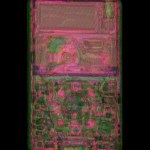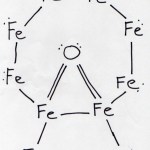Art
These gorgeous stipple-engraved plates come from The Anatomy of the Brain, Explained in a Series of Engravings, by Sir Charles Bell. The book was first published in 1802 and contained 12 plates, 11 of which were printed in colour; these come from an edition which appeared in 1823.
In the introduction to the book, Bell wrote:
In the Brain the appearance is so peculiar, and so little capable of illustration from other parts of the body, the surfaces are so soft, and so easily destroyed by rude dissection, and it is so difficult to follow an abstract description merely, that this part of…
There are several other versions online, and plans to sell them as full sized posters.
The Amygdaloids at the 92d Y, 4/3/08. Music starts at about 3m. LeDoux's the guitarist who is NOT singing. (Maybe it scares him?)
A few months back I gave a heads-up that NYU neuroscientist Joe LeDoux and his band, t the Amygdaloids, were playing in NYC. Well, the virus has spread! At Rock-It Science, March 3 in NYC, LeDoux and his band, the Amygdaloids (LeDoux pretty much owns the amygdala via his work on fear mechanisms) are to be joined on March 3 in NYC by other musical scientists-would-be-rock-stars, science bands, and science writers such as Pardis Sabetti (Harvard), David Soldier (…
An illustration of the Yale mastodon mount.
While planting corn on his Iowa farm around 1872 a farmer named Peter Mare found a curious carving. It was a smoking pipe in the shape of an elephant, a very odd item indeed, and he used it for its intended purpose until he moved to Kansas in 1878. At that time he gave it to his brother-in-law, but soon after a Reverend Gass came calling. Gass, an amateur archaeologist, wanted to purchase it, but the pipe was not for sale. Even so, the owner of the pipe allowed Gass to photograph it and make some casts, which he shared with the members of the…
Ever wondered what an iPod looks like through the eyes of a computed axial tomography scanner? Wonder no more! Radiologyart.com reveals what lies inside common household objects, from electronics to food to toys. They say:
Since the summer of 2007, the Radiology Art project has been underway. This is a project dedicated to the deeper visualization of various objects that hold unique cultural importance in modern society. So far, these objects have included toys, convenience-related foods, and personal electronics.
Here are some of the highlights:
A toy elephant containing a pull-string…
Oh man. This is good.
Via Kottke, who has other mixes as well.
Soviet Army dance ensemble + Run DMC = the invention of breakdancing in the mid-1900s.
Last fall, most of the Oxford Biochemistry Department moved into a fancy-schmancy new building (imaginatively named "New Biochemistry"). A few of us stayed behind (have you ever tried to move a 6-magnet NMR facility?), and--to be totally honest--I can't say that I'm too disappointed about this. Granted, the new building is notable enough to warrant a recent write-up in Nature due to its open design and various art installations. On the other hand, I think that most of the faculty, postdocs, and students in the department are probably more interested in doing serious science, so this is…
Now this is pretty cool. Since 2007 the Australopithecus afarensis skeleton AL 288-1, that's "Lucy" to you and me, has been on tour in an exhibit called "Lucy's Legacy - The Hidden Treasures of Ethiopia." I don't know if the exhibit is going to come close enough to me to allow me to visit it, but thanks to the website eLucy, I can look at the skeleton from home.
Hosted by the University of Texas at Austin, the website allows you to compare Lucy's bones with those of a human or a chimpanzee. This is a great resource for anyone who has been aching for a closer look at the fossils than is often…
In this week's episode of Science Saturday, John Horgan chats with philosopher Denis Dutton about his book, "The Art Instinct," which argues that our artistic values are due, in significant part, to biological adaptations dating back to the Pleistocene.
Next, John and Denis discuss sex and creativity, why there is no art of smell, and the appeal for highly abstract art.
G.J. Romanes
With the 200th anniversary of Charles Darwin's birth just two weeks away there is sure to be a spike in articles, lectures, and other events meant to honor the great naturalist. These homages to Darwin can be instructive, but they lack a personal touch; what we know of Darwin comes from his books, letters, and the numerous biographies of his life.
The scientist George John Romanes, however, did know Darwin and was among the youngest of the Darwinists. Even though we often speak of Huxley, Hooker, Gray, and Lyell as being among Darwin's closest friends, Romanes also had a very…
Some of the things psychologists ask their research subjects to do are really rather annoying. I'm not talking about Milgram-esque studies where people confront their inner demons, I'm talking about much more pedestrian stuff. This movie, for example, gives you a small taste of the Sustained Attention to Response Test (SART). A series of numbers will flash by, about 1 per second. While you watch, tap your finger on your desk for each number except the number 4. Give it a whirl:
In some ways, it's a completely mindless task, but you have to keep paying attention or you'll end up tapping when…
Publisher Penguin are marking the 150th anniversary of Charles Darwin's The Origin of Species with this rather splendid edition boasting cover art painted by Damien Hirst.
Says Hirst of the project:
I was given a paperback copy of On the Origin of Species many years ago by a friend and I loved it, especially the contentious aspects of it. Being brought up a Catholic and questioning the nonsensical creation theory, it was exciting... I suppose the work, in a modest way, acknowledges Darwin's analytical mind and his courage to believe in those ideas that questioned the very fabric of existence…
The AMNH mount of the Warren Mastodon. From The American Museum Journal.
Glendon's session on Art & Science last weekend inspired me to intensify my search for bits of paleontological art, and I have been fortunate enough to uncover some more verses about a prehistoric beast. Here is Hannah F. Gould's "The Mastodon", published in the prosaically-titled New Poems in 1850;
THE MASTODON.
Thou ponderous truth, from thy long night's sleep
Through the unrecorded eras
Awaked, and come from their darkness deep
To this day of light chimeras! --
What wast thou, when thy mountain form
Stood forth…
A Megatherium, from The Testimony of the Rocks by Hugh Miller.
I can't believe I didn't think of it at the time. During Glendon's session on Art & Science last weekend he asked the audience for specific examples of how art & science influenced each other. A few examples from modern science fiction films came to my mind but I forgot the most obvious example of all; cave art! The paintings made by ancient humans are not only beautiful but reveal details about extinct creatures as they were in life, thus being of value both as art and objects of scientific inquiry.
But what about…
Off my usual route -- but isn't Obama on everyone's today?
Much to admire in the man. Seems almost too much to ask that his signature could be so attractive as well. But there it is. This is from the first proclamation he signed soon after taking office.
That's from Reuters . Another site has signatures of all the previous presidents.
Why do I love paper art so much? Intersection of book, art, and (by presentation here) new media? Or is just because it's pretty?
This certainly is. A video of a walk through a highly literary society. I love the nighttime section.
From the folks at 4th Estate
Hat tip: Alice
tags: Christopher Street, Sheridan Square, The Greenwich Village Murals, subway art, NYC through my eye, photography, NYC
The Greenwich Village Murals, 1994.
Artist: Lee Brozgold and the students of P.S. 41. Mosaic and ceramic tiles at Christopher Street/Sheridan Square (Uptown 1 train). Panel 3.
Image: GrrlScientist, 27 December 2008 [larger view].
This mural depicts people who were instrumental in establishing the Village, including an early land developer, the publisher of New York's first African-American newspaper, a muralist, and a novelist who immortalized Washington Square -- all…
tags: Christopher Street, Sheridan Square, The Greenwich Village Murals, subway art, NYC through my eye, photography, NYC
The Greenwich Village Murals, 1994.
Artist: Lee Brozgold and the students of P.S. 41. Mosaic and ceramic tiles at Christopher Street/Sheridan Square (Uptown 1 train). Panel 1.
Image: GrrlScientist, 27 December 2008 [larger view].
This mural depicts people who were instrumental in establishing the Village, including an early land developer, the publisher of New York's first African-American newspaper, a muralist, and a novelist who immortalized Washington Square -- all…
tags: Christopher Street, Sheridan Square, The Greenwich Village Murals, subway art, NYC through my eye, photography, NYC
The Greenwich Village Murals, 1994.
Artist: Lee Brozgold and the students of P.S. 41. Mosaic and ceramic tiles at Christopher Street/Sheridan Square (Uptown 1 train).
Image: GrrlScientist, 27 December 2008 [larger view].
This mural depicts people who were instrumental in establishing the Village, including an early land developer, the publisher of New York's first African-American newspaper, a muralist, and a novelist who immortalized Washington Square -- all gathered…


